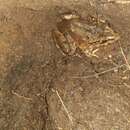en
names in breadcrumbs


The fanged river frog, Limnonectes macrodon, is a large bodied ranid frog now thought limited in distribution to Java and Sumatra.It has long been confused with the similar Limnonectes blythii, which is a species complex ranging widely across the mainland and archipelagos of southeast Asia.A terrestrial species, the fanged river frog lives in lowland forested areas (up to at least 700 m asl) near flowing streams, in which it breeds (Iskandar et al. 2004; Frost 2016).
Limnonectes macrodon is known by multiple common names.Others include Javan Giant Frog, Brown mountain frog, Malaya Wart Frog and Stone Creek Frog.
Although at one time this was a common species, Limnonectes macrodon is now listed by the IUCN as of vulnerable status.It is threatened by habitat loss, degradation of water quality, and over collection as a food source (Iskandar et al. 2004; Warkentin et al. 2009).In addition to being used for local subsistence, it is one of the heavily harvested species supplying frog legs for international export (Defenders of Wildlife 2011).
The fanged river frog, Javan giant frog, Malaya wart frog, or stone creek frog (Limnonectes macrodon) is a species of frog in the family Dicroglossidae endemic to Sumatra and Java, Indonesia. Records from other regions are probably caused by misidentifying other species such as Limnonectes blythii as this species.[2]
L. macrodon frogs live in forested areas near streams; they breed in streams. Their lowland forest habitat is declining in both the extent and quality, and this once common species is getting uncommon.[1] It is widely collected for human consumption in Java, Indonesia, along with the crab-eating frog (Fejervarya cancrivora).[3]
The fanged river frog, Javan giant frog, Malaya wart frog, or stone creek frog (Limnonectes macrodon) is a species of frog in the family Dicroglossidae endemic to Sumatra and Java, Indonesia. Records from other regions are probably caused by misidentifying other species such as Limnonectes blythii as this species.
L. macrodon frogs live in forested areas near streams; they breed in streams. Their lowland forest habitat is declining in both the extent and quality, and this once common species is getting uncommon. It is widely collected for human consumption in Java, Indonesia, along with the crab-eating frog (Fejervarya cancrivora).